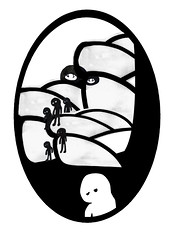Article published in Turkish in Bant magazine (issue 35)
A stunningly beautiful woman in a bright-coloured dress carrying a water canister on her head in the tormenting heat of a desert. A group of wide-eyed children with bloated stomachs staring straight into the camera with flies on their faces. A corpse of a black man pecked by vultures. Thousands and thousands of tents, thousands of people waiting in line for fresh water.
We’ve all seen these images over and over again. As time goes by, the killings of dozens and hundreds of people in Darfur or starvation in Ethiopia stop being breaking news and we turn for new catastrophes and new imagery. Dave Eggers’ latest novel What is the What (Hamish Hamilton 2006) follows the path of Valentino Achak Deng from the Sudanese village of Marial Bai to a suburb of Atlanta. The biography is a powerful slap on the Western face. We cannot dare to forget.
Eggers’ first novel, autobiography A Heartbreaking Work of A Staggering Genius was a bestseller worldwide. The tale of a young man in a somewhat late puberty bringing up his brother alone was praised for the extraordinary combination of wit and intimacy. The novelist’s involvement in supporting young writers through his publishing house McSweeney’s and founding of creative writing schools into American suburbs turned him quickly into a young star and a pet of the media. Although he has published a novel and short stories during the last years, What is the What is Eggers’ strongest and most passionate work since the autobiography. Valentino Achak Deng’s story is an extremely unsettling take on the human suffering behing the newsfeed. Through Valentino the common images of the conflict and famine suddenly get a human face.
Stylistically What is the What continues on the familiar path from Eggers’ previous novels. He has the patience for details whether when describing how Valentino buries his friend on the walk through the Sudanese desert or how it feels when burglars drop a phonebook right on your face. Eggers has told in the numerous interviews on the novel that he spent nearly two years with Valentino including a trip to Sudan. The intimate contact between the author and the protagonist grabs the reader firmly from the first page. Dave Eggers as a white New Yorker amazes with his skill to get skin-deep on how life is in a refugee camp or a Sudanese village. Eggers’ eye for absurdity and humour carries the book through the rough incidents for instance by describing the way the often naïve Western and Japanese aid workers are perceived by the refugees.
One cannot complete the novel without being moved and shaken. What is the What is a masterpiece in showing parallel the inequality of the American health care system and the hatred and complexity feeding the conflict in Sudan. Valentino Achak Deng’s life reminds the reader that refugees like him are not ignorant bystanders but people with dreams, anger, families and joys. During his life by now Deng has already gone through things no human being ought to experience. Teenager boys should not be seeing their friends losing the will to live or witnessing senseless killing. ”The unknown boys ran toward her”, he describes the violence feeding violence in Sudan. “Achor Achor stayed with me. When they were twenty feet from her, the woman turned, lifted a gun from the grass, and with her eyes full of white, she shot the taller boy through the heart. I could see the bullet leaving his back. His body kneeled and then fell on its side, his head landing before his shoulder.”
What is the What shows the ambitions of the thousands of Sudanese refugees in the United States without patronising them or denying their dignity. It also demonstrates to European readers how the American society simultaneously as a system treats the weakest like dirt but on the individual level opens their homes out of the sincere desire to help. Valentino Achak Deng’s journey from Eastern Africa to the Land of Hope and Glory depicts the frustration when you are denied from stability and forced to keep on running. ”I ran past villages that had been and were no more, ran past buses that were burned from the inside out, hands and faces pressed to the glass. Damn you all. Damn the living, damn the dead.”
The benefits from the book are donated to a foundation supporting Valentino’s education and the overall situation of the so-called Sudanese Lost Boys in the United States. Even if that alone would be reason enough to purchase the book, the best reason for giving your time for Valentino’s struggle is to be reminded of our privileged situation and therefore our responsibility to help.
Tommi Laitio
Eggers, Dave (2006): What is the What. Hamish Hamilton.
(Illustration by Hayal Pozanti)
Subscribe to:
Post Comments (Atom)












No comments:
Post a Comment